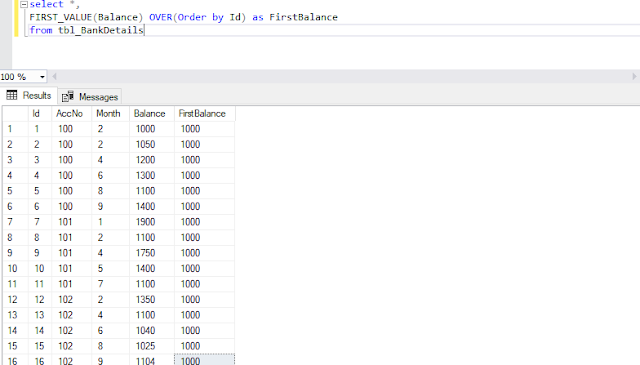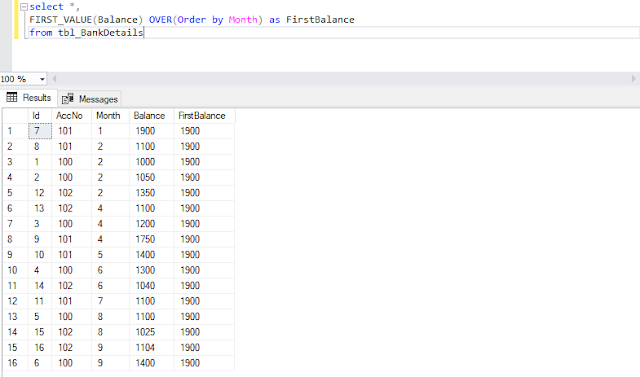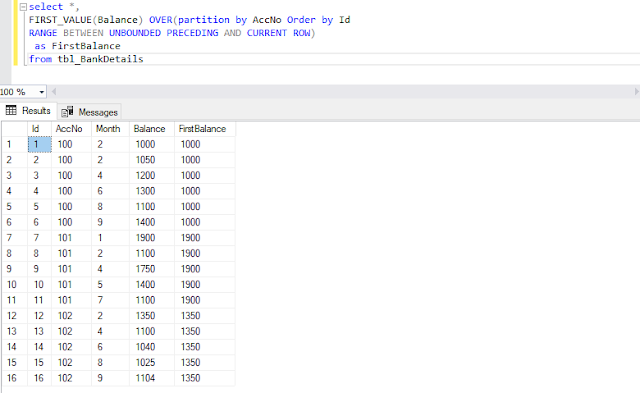 |
| FIRST VALUE Function in SQL Server |
The scalar_expression is an expression that returns single value. It does not permit other analytic functions. The partition_by_clause divides the returned list into partitions, Otherwise the function treats all the result list as a single group. The order_by_clause specifies which order the result set should be displayed?. The rows_range_clause specifies the range of rows to be returned in a result set.
Lets see this in detail using an example,
We are going to use "tbl_BankDetails" table for our demo.
CREATE TABLE [dbo].[tbl_BankDetails](
[Id] [bigint] IDENTITY(1,1) NOT NULL,
[AccNo] [varchar](450) NULL,
[Month] [bigint] NULL,
[Balance] [decimal](18, 0) NULL,
CONSTRAINT [PK_tbl_BankDetails] PRIMARY KEY CLUSTERED
(
[Id] ASC
)WITH (PAD_INDEX = OFF, STATISTICS_NORECOMPUTE = OFF, IGNORE_DUP_KEY = OFF, ALLOW_ROW_LOCKS = ON, ALLOW_PAGE_LOCKS = ON) ON [PRIMARY]
) ON [PRIMARY]
GO
-- insert some demo data
insert into tbl_BankDetails(AccNo, Month,Balance) values(100,2,1000);
insert into tbl_BankDetails(AccNo, Month,Balance) values(100,3,1050);
insert into tbl_BankDetails(AccNo, Month,Balance) values(100,4,1200);
insert into tbl_BankDetails(AccNo, Month,Balance) values(100,6,1300);
insert into tbl_BankDetails(AccNo, Month,Balance) values(100,8,1100);
insert into tbl_BankDetails(AccNo, Month,Balance) values(100,9,1400);
insert into tbl_BankDetails(AccNo, Month,Balance) values(101,1,1900);
insert into tbl_BankDetails(AccNo, Month,Balance) values(101,2,1100);
insert into tbl_BankDetails(AccNo, Month,Balance) values(101,4,1750);
insert into tbl_BankDetails(AccNo, Month,Balance) values(101,5,1400);
insert into tbl_BankDetails(AccNo, Month,Balance) values(101,7,1100);
insert into tbl_BankDetails(AccNo, Month,Balance) values(102,2,1350);
insert into tbl_BankDetails(AccNo, Month,Balance) values(102,4,1100);
insert into tbl_BankDetails(AccNo, Month,Balance) values(102,6,1040);
insert into tbl_BankDetails(AccNo, Month,Balance) values(102,8,1025);
insert into tbl_BankDetails(AccNo, Month,Balance) values(102,9,1104);
[Id] [bigint] IDENTITY(1,1) NOT NULL,
[AccNo] [varchar](450) NULL,
[Month] [bigint] NULL,
[Balance] [decimal](18, 0) NULL,
CONSTRAINT [PK_tbl_BankDetails] PRIMARY KEY CLUSTERED
(
[Id] ASC
)WITH (PAD_INDEX = OFF, STATISTICS_NORECOMPUTE = OFF, IGNORE_DUP_KEY = OFF, ALLOW_ROW_LOCKS = ON, ALLOW_PAGE_LOCKS = ON) ON [PRIMARY]
) ON [PRIMARY]
GO
-- insert some demo data
insert into tbl_BankDetails(AccNo, Month,Balance) values(100,2,1000);
insert into tbl_BankDetails(AccNo, Month,Balance) values(100,3,1050);
insert into tbl_BankDetails(AccNo, Month,Balance) values(100,4,1200);
insert into tbl_BankDetails(AccNo, Month,Balance) values(100,6,1300);
insert into tbl_BankDetails(AccNo, Month,Balance) values(100,8,1100);
insert into tbl_BankDetails(AccNo, Month,Balance) values(100,9,1400);
insert into tbl_BankDetails(AccNo, Month,Balance) values(101,1,1900);
insert into tbl_BankDetails(AccNo, Month,Balance) values(101,2,1100);
insert into tbl_BankDetails(AccNo, Month,Balance) values(101,4,1750);
insert into tbl_BankDetails(AccNo, Month,Balance) values(101,5,1400);
insert into tbl_BankDetails(AccNo, Month,Balance) values(101,7,1100);
insert into tbl_BankDetails(AccNo, Month,Balance) values(102,2,1350);
insert into tbl_BankDetails(AccNo, Month,Balance) values(102,4,1100);
insert into tbl_BankDetails(AccNo, Month,Balance) values(102,6,1040);
insert into tbl_BankDetails(AccNo, Month,Balance) values(102,8,1025);
insert into tbl_BankDetails(AccNo, Month,Balance) values(102,9,1104);
Now, Lets see how to use FIRST_VALUE() function in a SELECT statement:
The FIRST_VALUE() function produces the first balance based on the order of the Id. The returned result set is,
If you want to get first balance based on the order of the month your SELECT statement should be like this,
The returned result is,
The FirstBalance is the Balance of the first month that you can see in the above result set.
In order to get first balance based on each account number, we need to use RANGE BETWEEN UNBOUNDED PRECEDING AND CURRENT ROW in our OVER statement like below:
The returned result is,





Comments